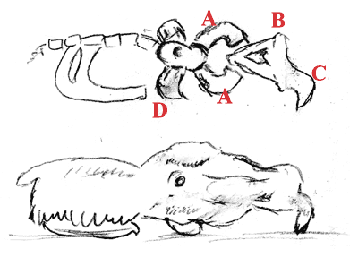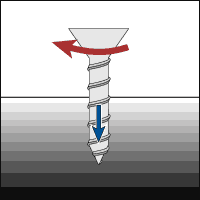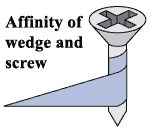 |
Introduction Site Map Email: jja@nac.net |

"I don't know. It is Odin's disk and it has only one side."
— J. L. Borges, The Disk.


Monday, August 9th, 2004
I'll continue discussing simple machines as the basis for various animals (mostly as a chain of negative examples). You may wish to refer to the previous article.
 Before we proceed... I thought of a slightly more
efficient animal that uses a wedge; it's pictured at right. Powerful
jaws A squeeze wedge B until hook C is extended; the hook catches in
the ground and the animal retracts the wedge with its cheek muscles,
pulling the whole critter along. This uses the inverse wedge principle
which I mentioned last time. The animal feeds by using its forward
runner D as a scoop for bugs
and plants.
Before we proceed... I thought of a slightly more
efficient animal that uses a wedge; it's pictured at right. Powerful
jaws A squeeze wedge B until hook C is extended; the hook catches in
the ground and the animal retracts the wedge with its cheek muscles,
pulling the whole critter along. This uses the inverse wedge principle
which I mentioned last time. The animal feeds by using its forward
runner D as a scoop for bugs
and plants.While superior to the last design, this animal would still lose a speed contest to a turtle. If you want a flexible animal that can move quickly, wedges appear to be right out.
Now let's have a look at the screw.
 A screw turns a
rotational force (large red arrow) into a linear force (small blue
arrow). As far as 'simple' machines go, the screw is a relative
latecomer; the other machines can usually be hewn roughly out of wood
or stone, or hammered out of metal. Making a screw requires craft and
attention to detail.
A screw turns a
rotational force (large red arrow) into a linear force (small blue
arrow). As far as 'simple' machines go, the screw is a relative
latecomer; the other machines can usually be hewn roughly out of wood
or stone, or hammered out of metal. Making a screw requires craft and
attention to detail. The screw is a close cousin of the wedge, as the picture
at right demonstrates. Wrap a wedge (strictly speaking, the edge of a
wedge) around a cylinder and you get the screw.
The screw is a close cousin of the wedge, as the picture
at right demonstrates. Wrap a wedge (strictly speaking, the edge of a
wedge) around a cylinder and you get the screw.Aside from holding things together, the screw principle is used in machines (the 'worm gear,' which rotates a standard gear), drill bits, and propellers...
Propellers! So we have a motive principle in the screw that works in the real world, and which makes things go fast... Sadly, we hit a few snags right off. First, the propeller only makes things go fast when it can be made to turn very rapidly, at a speed which machines can handle but which would likely be unsustainable for creatures of flesh and blood. Second, I'm covering locomotion on land, and the propeller works best in low friction environments such as air and water. (Have you ever seen a comic book which had a mining machine with a big conical drill bit on the front, which could just casually dig itself into the ground and tunnel wherever it wanted to go? There's a reason why real-world mining machines bear almost no resemblance to this design...)
So if not a propeller, what would work? I have an animal designed which I'm still drawing in detail, and which I'll present in an update later this evening...
Update: I'm in the middle of a computer upgrade, so 'this evening' has now become next Thurdsay. See you then.



pageatatime.com is hosted by net access corporation - www.nac.net